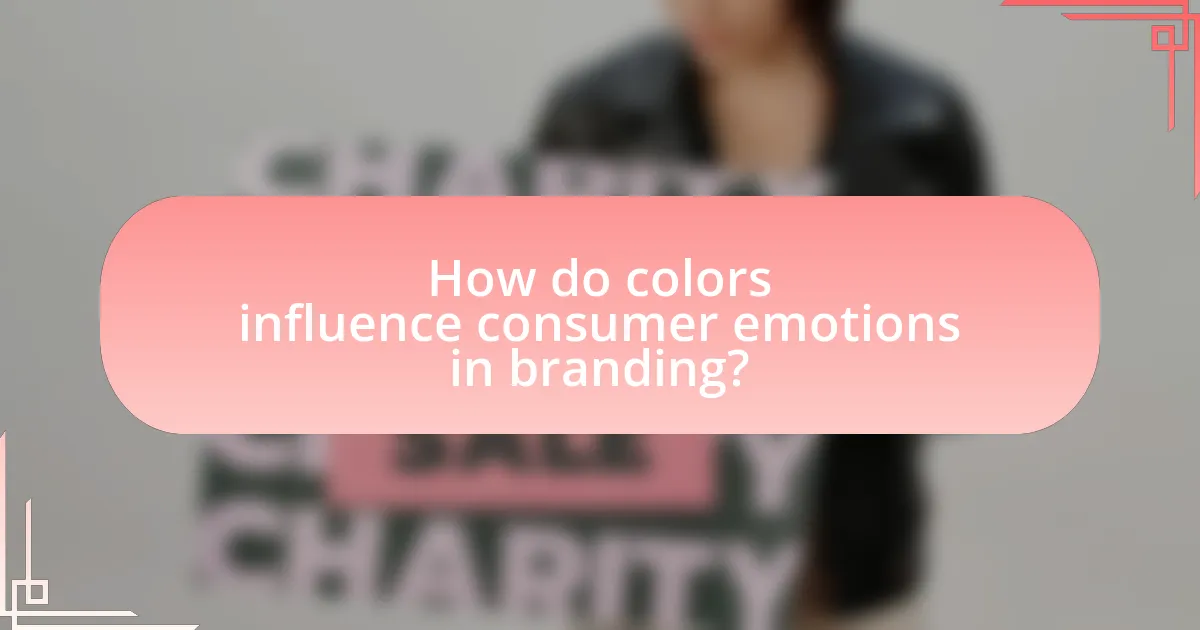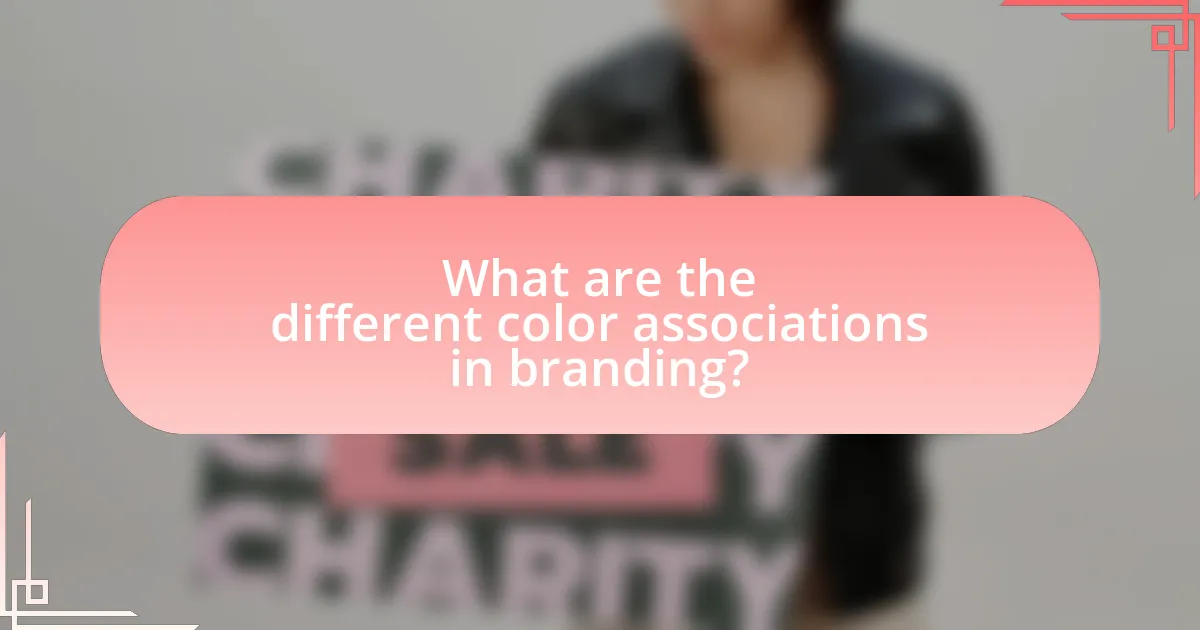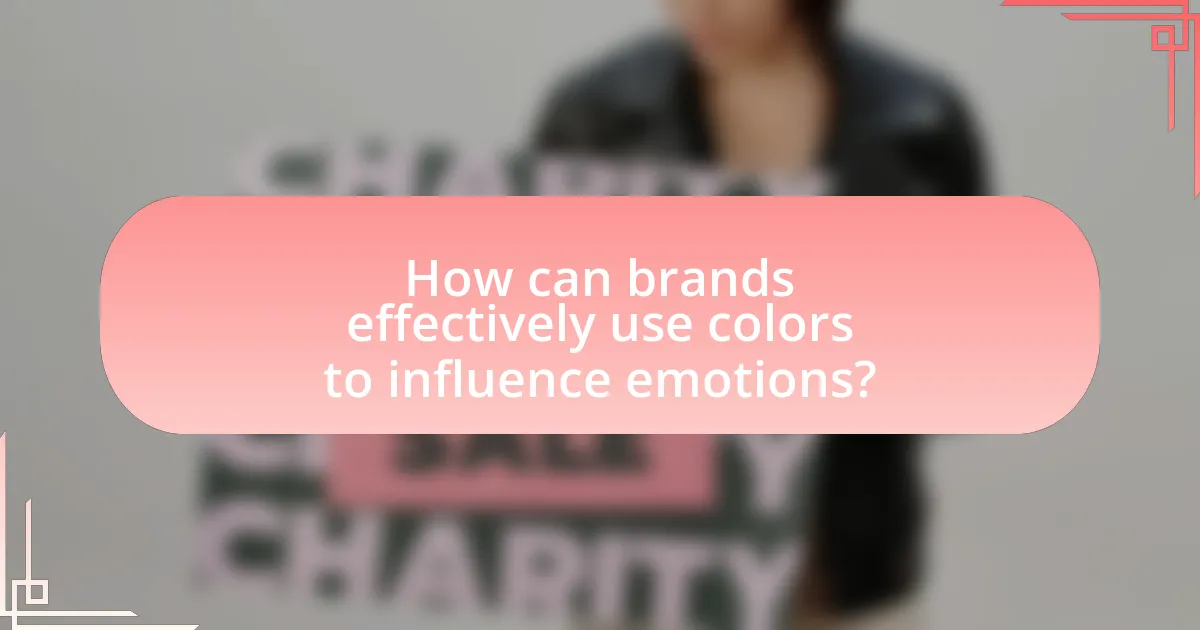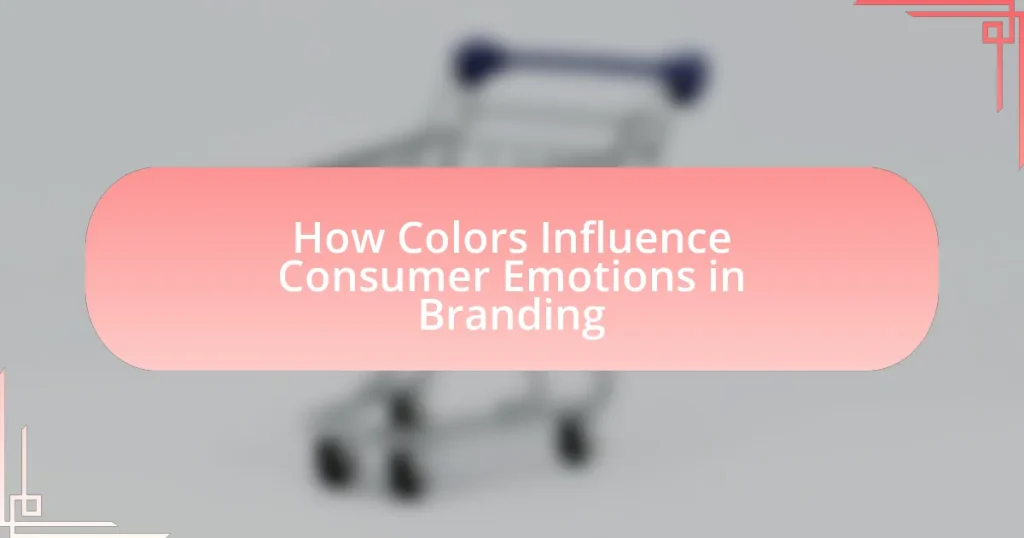The article examines how colors influence consumer emotions in branding, highlighting the psychological effects of different hues on purchasing decisions. It discusses the emotional associations of warm colors, such as red and yellow, which evoke excitement and urgency, and cool colors, like blue and green, which convey trust and tranquility. The significance of color choice in branding is emphasized, noting that it can increase brand recognition by up to 80% and impact consumer perceptions. Additionally, the article addresses cultural differences in color interpretation and provides strategies for brands to effectively utilize color to enhance emotional engagement and avoid negative responses.

How do colors influence consumer emotions in branding?
Colors significantly influence consumer emotions in branding by evoking specific feelings and associations. For instance, research indicates that blue often conveys trust and dependability, making it a popular choice for financial institutions, while red can evoke excitement and urgency, frequently used in clearance sales. A study by the Institute for Color Research found that color can increase brand recognition by up to 80%, demonstrating its powerful role in shaping consumer perceptions and emotional responses. Thus, the strategic use of color in branding not only enhances visual appeal but also directly impacts consumer behavior and emotional engagement.
What psychological effects do colors have on consumers?
Colors significantly influence consumer emotions and behaviors, impacting their purchasing decisions. For instance, research indicates that 85% of consumers make purchasing decisions based on color alone, as colors evoke specific feelings and associations. Red often stimulates excitement and urgency, making it effective for clearance sales, while blue conveys trust and reliability, commonly used by financial institutions. Additionally, yellow can evoke feelings of happiness and optimism, attracting attention in marketing materials. These psychological effects are rooted in cultural associations and personal experiences, demonstrating that color choice in branding can directly affect consumer perception and engagement.
How do warm colors evoke specific emotions?
Warm colors, such as red, orange, and yellow, evoke specific emotions by stimulating feelings of warmth, excitement, and energy. These colors are often associated with positive emotions like happiness and enthusiasm, as well as feelings of comfort and safety. For instance, red can increase heart rates and create a sense of urgency, which is why it is frequently used in marketing to grab attention and encourage action. Research indicates that warm colors can enhance feelings of warmth and comfort, making them effective in branding strategies aimed at creating a welcoming atmosphere. A study published in the Journal of Consumer Research found that warm colors significantly influence consumers’ emotional responses, leading to increased engagement and a higher likelihood of purchase.
What emotions are associated with cool colors?
Cool colors, such as blue, green, and purple, are primarily associated with emotions like calmness, tranquility, and relaxation. These colors evoke feelings of serenity and peace, often used in branding to create a sense of trust and reliability. Research indicates that blue can lower heart rates and reduce anxiety, while green is linked to nature and renewal, promoting a sense of balance. Additionally, purple is often associated with creativity and luxury, enhancing feelings of sophistication. These emotional associations make cool colors effective tools in branding strategies aimed at fostering positive consumer experiences.
Why is color choice important in branding?
Color choice is important in branding because it significantly influences consumer perception and emotional response. Research indicates that colors can increase brand recognition by up to 80%, demonstrating their power in shaping consumer attitudes. For instance, blue is often associated with trust and reliability, making it a popular choice for financial institutions, while red evokes excitement and urgency, frequently used in sales promotions. These associations are rooted in psychological studies, such as those conducted by the Institute for Color Research, which found that people make a subconscious judgment about a person, environment, or product within 90 seconds, and between 62% to 90% of that assessment is based on color alone. Thus, effective color selection is crucial for brands to communicate their values and connect emotionally with their target audience.
How does color impact brand recognition?
Color significantly impacts brand recognition by influencing consumer perceptions and emotional responses. Research indicates that color can increase brand recognition by up to 80%, as it helps create a visual identity that consumers can easily associate with a brand. For instance, brands like Coca-Cola and McDonald’s utilize red and yellow, respectively, to evoke feelings of excitement and happiness, enhancing their memorability. This connection between color and emotion is supported by studies, such as those conducted by the Institute for Color Research, which found that people make a subconscious judgment about a product within 90 seconds of initial viewing, with color being a primary factor in that decision.
What role does color play in consumer decision-making?
Color significantly influences consumer decision-making by affecting emotions and perceptions associated with products. Research indicates that up to 90% of snap judgments made about products can be based on color alone, highlighting its critical role in attracting attention and conveying brand identity. For instance, studies show that warm colors like red and yellow can evoke feelings of excitement and urgency, while cooler colors like blue and green tend to promote calmness and trust. This emotional response to color can directly impact purchasing behavior, as consumers often associate specific colors with particular qualities or values, ultimately guiding their choices in the marketplace.

What are the different color associations in branding?
Different colors in branding evoke specific associations and emotions that influence consumer perceptions. For instance, blue is often associated with trust and reliability, making it popular among financial institutions like banks. Red conveys excitement and urgency, frequently used in sales promotions and food brands to stimulate appetite. Green symbolizes health, tranquility, and nature, commonly adopted by eco-friendly brands. Yellow represents optimism and warmth, often utilized in brands targeting a youthful audience. Black signifies luxury and sophistication, frequently seen in high-end products. These associations are supported by studies, such as those conducted by the Institute for Color Research, which found that color can increase brand recognition by up to 80%.
How do cultural differences affect color perception?
Cultural differences significantly affect color perception, influencing how individuals interpret and respond to colors based on their cultural backgrounds. For instance, in Western cultures, white is often associated with purity and weddings, while in many Eastern cultures, it symbolizes mourning and funerals. This divergence in color symbolism can impact branding strategies, as companies must consider cultural contexts to effectively communicate their messages. Research by Aslam (2006) in the Journal of Fashion Marketing and Management highlights that color preferences vary across cultures, with specific colors eliciting different emotional responses, thereby affecting consumer behavior and brand perception.
What colors are preferred in Western cultures?
In Western cultures, blue, red, and green are among the most preferred colors. Blue is often associated with trust and reliability, making it a popular choice in branding, particularly for financial institutions and technology companies. Red evokes strong emotions, such as excitement and passion, which is why it is frequently used in marketing to grab attention. Green symbolizes nature and health, appealing to consumers’ desires for sustainability and wellness. Studies have shown that these colors significantly influence consumer emotions and purchasing decisions, reinforcing their importance in branding strategies.
How do Eastern cultures interpret colors differently?
Eastern cultures interpret colors with distinct meanings that often differ from Western interpretations. For example, in many Eastern societies, red symbolizes good fortune and joy, making it a popular choice for celebrations and weddings, while in Western cultures, red can signify danger or warning. Additionally, white is associated with purity and new beginnings in Western contexts, but in several Eastern cultures, such as Chinese and Indian, it is linked to mourning and funerals. These cultural associations influence consumer emotions and branding strategies, as brands must consider these interpretations to resonate effectively with their target audiences.
What are the common color meanings in branding?
Common color meanings in branding include specific associations that influence consumer perceptions and emotions. For example, blue often conveys trust and reliability, making it popular among financial institutions like banks. Red typically evokes excitement and urgency, frequently used in sales promotions. Green symbolizes health and tranquility, commonly adopted by eco-friendly brands. Yellow represents optimism and warmth, often utilized in brands targeting a youthful audience. Black signifies sophistication and luxury, frequently seen in high-end products. These associations are supported by psychological studies, such as those conducted by the Institute for Color Research, which found that color can increase brand recognition by up to 80%.
What does the color red signify in marketing?
The color red signifies excitement, passion, and urgency in marketing. It is often used to grab attention and stimulate quick decision-making, making it effective for sales promotions and calls to action. Research indicates that red can increase heart rates and create a sense of urgency, which is why it is frequently employed in clearance sales and limited-time offers. For instance, a study published in the Journal of Consumer Research found that red can enhance consumers’ perception of urgency, leading to faster purchasing decisions.
How is blue perceived in corporate branding?
Blue is perceived in corporate branding as a color that conveys trust, professionalism, and reliability. This perception is supported by studies indicating that blue is often associated with feelings of calmness and security, making it a popular choice among financial institutions and technology companies. For instance, a survey by the Institute for Color Research found that people make a judgment about a product within 90 seconds of seeing it, and color accounts for 85% of that decision, with blue being favored for its association with stability and dependability.

How can brands effectively use colors to influence emotions?
Brands can effectively use colors to influence emotions by strategically selecting hues that evoke specific feelings and associations. For instance, blue is often linked to trust and calmness, making it a popular choice for financial institutions, while red can evoke excitement and urgency, frequently used in clearance sales. Research indicates that color can increase brand recognition by up to 80%, demonstrating its significant impact on consumer perception and emotional response. By understanding color psychology, brands can tailor their visual identity to resonate with their target audience, enhancing emotional engagement and driving purchasing decisions.
What strategies can brands implement for color selection?
Brands can implement several strategies for color selection to effectively influence consumer emotions. First, brands should conduct market research to understand the psychological associations of colors within their target demographic, as different cultures and age groups may perceive colors differently. For example, studies show that blue often evokes feelings of trust and calmness, making it a popular choice for financial institutions. Additionally, brands can utilize color theory principles, such as complementary and analogous color schemes, to create visually appealing designs that resonate emotionally with consumers. Furthermore, brands should consider the context in which their colors will be viewed, as colors can appear differently under various lighting conditions and backgrounds. By aligning color choices with brand identity and consumer expectations, brands can enhance emotional connections and drive purchasing decisions.
How can brands test color effectiveness with consumers?
Brands can test color effectiveness with consumers by conducting A/B testing, where different color variations of a product or advertisement are shown to distinct consumer groups to measure preferences and engagement levels. This method allows brands to gather quantitative data on consumer reactions, such as click-through rates or purchase intentions, directly linked to specific colors. Research indicates that colors can significantly influence emotions and decision-making; for instance, a study published in the Journal of Business Research found that color affects brand perception and consumer behavior, highlighting the importance of color choices in marketing strategies.
What are the best practices for color combinations in branding?
The best practices for color combinations in branding include using complementary colors, maintaining a limited color palette, and considering color psychology. Complementary colors, which are opposite each other on the color wheel, create visual interest and harmony, enhancing brand recognition. A limited color palette, typically consisting of two to four colors, ensures consistency and simplicity, making the brand more memorable. Additionally, understanding color psychology is crucial; for example, blue often conveys trust, while red can evoke excitement. Research indicates that color can increase brand recognition by up to 80%, highlighting the importance of effective color combinations in branding strategies.
What are the potential pitfalls of color misuse in branding?
The potential pitfalls of color misuse in branding include misalignment with brand identity, negative consumer perception, and reduced brand recognition. Misalignment occurs when the colors chosen do not reflect the brand’s values or target audience, leading to confusion about the brand’s message. For example, a luxury brand using bright, playful colors may fail to convey sophistication, alienating its intended market. Negative consumer perception can arise when colors evoke unintended emotions; for instance, using red in a health-related brand may trigger feelings of danger rather than trust. Additionally, reduced brand recognition happens when colors are too similar to competitors, making it difficult for consumers to distinguish the brand. Research indicates that color can influence up to 90% of a consumer’s first impression of a product, highlighting the importance of strategic color choices in branding.
How can brands avoid negative emotional responses to color choices?
Brands can avoid negative emotional responses to color choices by conducting thorough market research to understand the cultural and psychological associations of colors within their target audience. This approach is essential because colors evoke specific emotions and reactions; for instance, red can signify excitement or danger, while blue often conveys trust and calmness. Research indicates that 85% of consumers make purchasing decisions based on color, highlighting the importance of aligning color choices with brand messaging and audience expectations. By testing color palettes through focus groups or A/B testing, brands can gather data on emotional responses, ensuring that their color selections resonate positively with consumers and do not inadvertently trigger negative feelings.
What are common mistakes brands make with color in their branding?
Common mistakes brands make with color in their branding include using too many colors, which can create confusion and dilute brand identity. Brands often fail to consider color psychology, neglecting how colors evoke specific emotions and associations; for instance, blue is often linked to trust, while red can signify excitement. Additionally, brands may overlook cultural differences in color perception, leading to misinterpretations in global markets. Research indicates that 85% of consumers make purchasing decisions based on color, highlighting the importance of strategic color choices in branding.
What practical tips can brands use to leverage color for emotional impact?
Brands can leverage color for emotional impact by strategically selecting colors that align with their brand identity and target audience’s emotions. For instance, blue often evokes trust and calmness, making it suitable for financial institutions, while red can stimulate excitement and urgency, ideal for sales promotions. Research indicates that color increases brand recognition by up to 80%, highlighting its significance in consumer perception. Additionally, brands should consider cultural associations with colors, as meanings can vary globally; for example, white symbolizes purity in Western cultures but can represent mourning in some Eastern cultures. By understanding these emotional connections and cultural contexts, brands can effectively use color to enhance their messaging and resonate with consumers.


